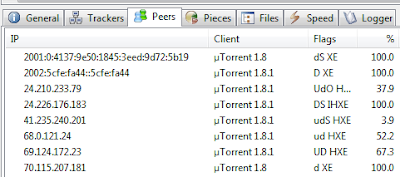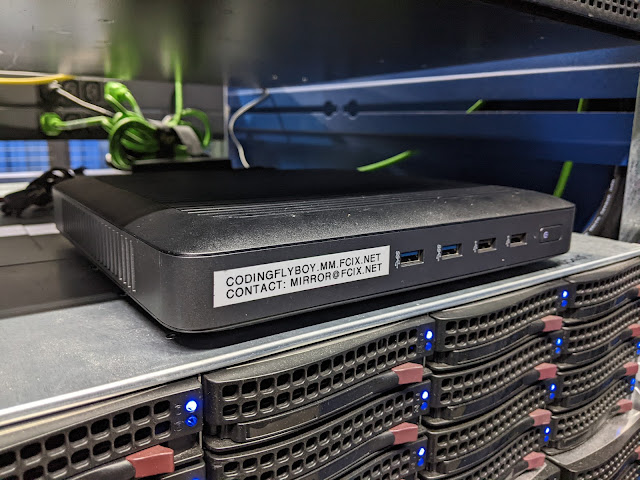IPv6 is Actually Real
I happened to scroll through my peer list in μtorrent, and two of them jumped out at me:
First two there on the list; those are true honest-to-goodness IPv6 IP addresses. This is really cool because IPv6 has been knocking around the technical internet since the mid-90s as the be all end all solution to the IP address depletion problem. This is really cool that I'm actually trading traffic with other hosts with one of my globally addressable IPv6 addresses, even if I am still on an IPv4 network (IP addresses that everyone is used to, ie 192.0.1.122).
The first address is a Teredo address. You can tell this because it's a 2001:0::/32 address (starts with 2001:0000:, which is 32 bits). It's like how you can identify 192.168.0.0/16 and 10.0.0.0/8 addresses as coming from within your private network, all part of the standard. Teredo is a system that uses UDT to tunnel out through your router and make your computer available through third party Teredo routers.
The second address is a 6to4 address, identified by its 2002::/16 prefix. 6to4 is a tunneling protocol allowing two 6to4 networks to communicate through IPv4 space. This address is even more exciting to me than the Teredo address because it means I'm managing to get out of the Teredo relay and talk to the rest of the IPv6 network (or at least a different transition system, who knows what's broken out there).
My descriptions really don't do either system justice, so I encourage anyone interested to click through to the Wikipedia articles (And reading RFCs just isn't any fun, trust me...). I hope someone appreciated my correct usage of the 192.0.0.0/16 network.
First two there on the list; those are true honest-to-goodness IPv6 IP addresses. This is really cool because IPv6 has been knocking around the technical internet since the mid-90s as the be all end all solution to the IP address depletion problem. This is really cool that I'm actually trading traffic with other hosts with one of my globally addressable IPv6 addresses, even if I am still on an IPv4 network (IP addresses that everyone is used to, ie 192.0.1.122).
The first address is a Teredo address. You can tell this because it's a 2001:0::/32 address (starts with 2001:0000:, which is 32 bits). It's like how you can identify 192.168.0.0/16 and 10.0.0.0/8 addresses as coming from within your private network, all part of the standard. Teredo is a system that uses UDT to tunnel out through your router and make your computer available through third party Teredo routers.
The second address is a 6to4 address, identified by its 2002::/16 prefix. 6to4 is a tunneling protocol allowing two 6to4 networks to communicate through IPv4 space. This address is even more exciting to me than the Teredo address because it means I'm managing to get out of the Teredo relay and talk to the rest of the IPv6 network (or at least a different transition system, who knows what's broken out there).
My descriptions really don't do either system justice, so I encourage anyone interested to click through to the Wikipedia articles (And reading RFCs just isn't any fun, trust me...). I hope someone appreciated my correct usage of the 192.0.0.0/16 network.


